Ansible之Playbook详解、案例
什么是playbook
playbooks是一个不同于使用Ansible命令行执行方式的模式,其功能更强大灵活。
简单来说,playbook是一个非常简单的配置管理和多主机部署系统,不同于任何已经存在的模式,可作为一个适合部署复杂应用程序的基础。
Playbook可以定制配置,可以按照指定的操作步骤有序执行,支持同步和异步方式。
值得注意的是playbook是通过YAML格式来进行描述定义的。
playbook是由一个或多个模块组成的,使用多个不同的模块,完成一件事情。
playbook通过yaml语法识别描述的状态文件。扩展名是yaml
YAML语法
缩进
YAML使用一个固定的缩进风格表示层级结构,每个缩进由两个空格组成, 不能使用tab
冒号
以冒号结尾的除外,其他所有冒号后面所有必须有空格。
短横线
表示列表项,使用一个短横杠加一个空格。
多个项使用同样的缩进级别作为同一列表。
核心元素
Tasks:任务,由模板定义的操作列表 Variables:变量 Templates:模板,即使用模板语法的文件 Handlers:处理器 ,当某条件满足时,触发执行的操作 Roles:角色
hosts和users介绍
---
- hosts: abc #可以是一个主机组、主机、多个主机,中间以冒号分隔,也可以用all参数表示所有主机
remote_user: root #表示执行的用户账号
become: yes #2.6版本以后的参数,之前是sudo,意思为切换用户运行
become_user: mysql #指定sudo用户为mysql
become 和become_user 作为指定远程主机sudo切换用
Tasks list 和action介绍
1、Play的主体部分是task列表,task列表中的各任务按次序逐个在hosts中指定的主机上执行,即在所有主机上完成第一个任务后再开始第二个任务。 2、在运行playbook时(从上到下执行),如果一个host执行task失败,整个tasks都会回滚,请修正playbook 中的错误,然后重新执行即可。 3、每一个task必须有一个名称name,这样在运行playbook时,从其输出的任务执行信息中可以很好的辨别出是属于哪一个task的。 如果没有定义name,‘action’的值将会用作输出信息中标记特定的task。 4、定义一个task,常见的格式:”module: options” 例如:yum: name=httpd 5、ansible的自带模块中,command模块和shell模块无需使用key=value格式
常用命令
# ansible-playbook first.yml --syntax-check #检查yaml文件的语法是否正确 # ansible-playbook first.yml --list-task #检查tasks任务 # ansible-playbook first.yml --list-hosts #检查生效的主机 # ansible-playbook first.yml --start-at-task='Copy Nginx.conf' #指定从某个task开始运行 # ansible-playbook first.yml -k #用来交互输入ssh密码 # ansible-playbook first.yml -K #用来交互输入sudo密码 # ansible-playbook first.yml -u #指定用户
playbook变量
变量使用
变量定义有三种方式
1) playbook的yaml文件中定义变量赋值 2) --extra-vars执行参数赋给变量 3) 在文件中定义变量
1、playbook的yaml文件中定义变量赋值
- hosts: all
vars: #定义变量
file_name: bgx_yaml_vars
tasks:
- name: # {{ file_name }}引用上面定义的变量
file: path=/tmp/{{ file_name }} state=touch
#playbook执行,在/tmp目录创建bgx_yaml_vars文件
2、--extra-vars执行参数赋给变量
[root@manager ~]# cat f3.yml
- hosts: all
tasks:
- name: Create New File
file: path=/tmp/{{ file_name }} state=touch
#playbook执行时传入file_name变量的参数,在/tmp目录创建bgx_extra-vars文件
[root@manager ~]# ansible-playbook f2.yml --extra-vars "file_name=bgx_extra-vars"
3) 在文件中定义变量: 可以在/etc/ansible/hosts主机组中定义,然后使用palybook进行调度该变量
cat /etc/ansible/hosts
[ceshi]
10.17.12.98
10.17.12.99
10.17.12.60
[ceshi:vars]
file_name=bgx_filename
[root@manager ~]# cat f4.yml
---
- hosts: all
tasks:
- name: Create New File
file: path=/tmp/{{ file_name }} state=touch
#playbook执行,在/tmp目录创建bgx_filename文件
如果定义的变量出现重复,且造成冲突,优先级如下:
1.extra-vars外置传参的优先级最高 [所有执行的主机都生效] 2.定义在yml文件中的优先级其次 [所有执行的主机都生效] 3.hosts文件中定义的变量优先级最低 [当前主机组定义会生效]
变量注册
1) 注册变量: register关键字可以存储指定命令的输出结果到一个自定义的变量中
[root@manager ~]# cat f5.yml
---
- hosts: all
tasks:
- name:
shell: netstat -lntp
register: System_Status
- name: Get System Status
debug: msg={{System_Status.stdout_lines}}
#playbook执行结果
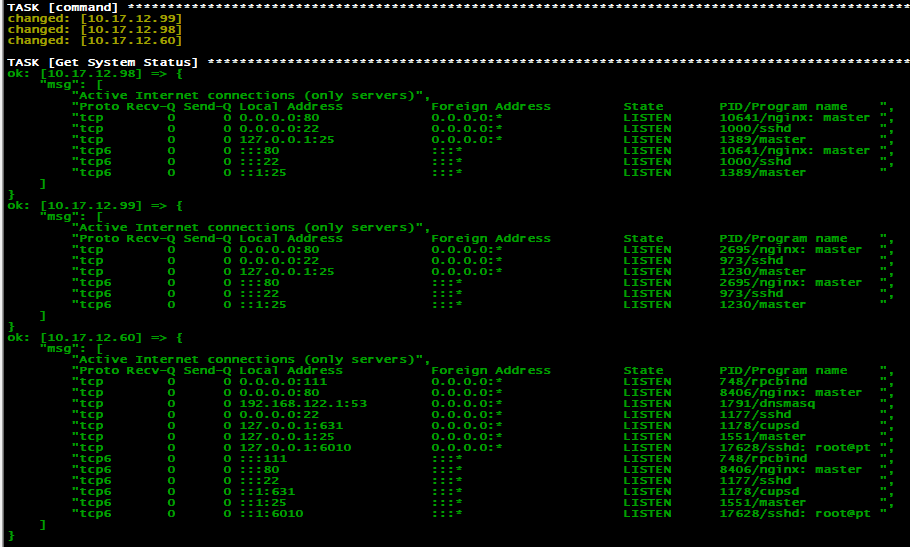
条件判断
playbook中的条件判断语句使用when
- hosts: all
remote_user: root
tasks:
#如果系统中存在主机名为nfs或者backup的主机,则创建文件
- name: Create File
file: path=/tmp/this_is_{{ ansible_hostname }}_file state=touch
when: (ansible_hostname == "nfs") or (ansible_hostname == "backup")
#系统为centos的主机才会执行
- name: Centos Install httpd
yum: name=httpd state=present
when: (ansible_distribution == "CentOS")
#系统为ubuntu的主机才会执行
- name: Ubuntu Install httpd
yum: name=httpd2 state=present
when: (ansible_distribution == "Ubuntu")
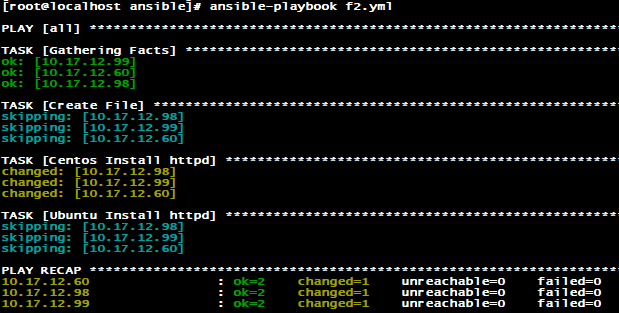
循环语句
1、标准循环使用场景-批量安装软件
[root@manager ~]# cat f7.yml
---
- hosts: all
remote_user: root
tasks:
- name: Installed Pkg
yum: name={{ item }} state=present
with_items:
- wget
- tree
- lrzsz
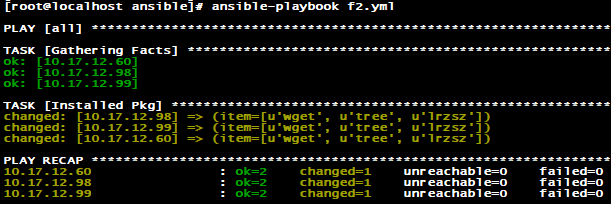
2、标准循环使用场景-批量创建用户
[root@manager ~]# cat f7.yml
- hosts: all
remote_user: root
tasks:
- name: Add Users
user: name={{ item.name }} groups={{ item.groups }} state=present
with_items:
- { name: 'testuser1', groups: 'bin' }
- { name: 'testuser2', groups: 'root' }

3、标准循环使用场景-拷贝多个目录
[root@manager ~]# cat f7.yml
- hosts: all
remote_user: root
tasks:
- name: Configure Rsync Server
copy: src={{ item.src }} dest=/etc/{{ item.dest }} mode={{ item.mode }}
with_items:
- {src: "rsyncd.conf", dest: "rsyncd.conf", mode: "0644"}
- {src: "rsync.passwd", dest: "rsync.passwd", mode: "0600"}
异常处理
默认Playbook会检查命令和模块的返回状态,如遇到错误就中断playbook的执行
加入参数: ignore_errors: yes 忽略错误
[root@manager ~]# cat f9.yml
---
- hosts: all
remote_user: root
tasks:
- name: Ignore False
command: /bin/false
ignore_errors: yes
- name: touch new file
file: path=/tmp/bgx_ignore state=touch

tags标签
1、打标签
对一个对象打一个标签
对一个对象打多个标签
对多个对象打一个标签
2、标签使用,通过tags和任务对象进行捆绑,控制部分或者指定的task执行
-t: 执行指定的tag标签任务
--skip-tags: 执行--skip-tags之外的标签任务
[root@manager ~]# cat f10.yml
---
- hosts: all
remote_user: root
tasks:
- name: Install Nfs Server
yum: name=nfs-utils state=present
tags:
- install_nfs
- install_nfs-server
- name: Service Nfs Server
service: name=nfs-server state=started enabled=yes
tags: start_nfs-server
使用-t指定tags执行, 多个tags使用逗号隔开即可
[root@manager ~]# ansible-playbook -t install_nfs-server f10.yml
使用--skip-tags排除不执行的tags
[root@manager ~]# ansible-playbook --skip-tags install_nfs-server f10.yml
playbook参数
执行方式:ansible-playbook playbook.yml [options]
-u REMOTE_USER, --user=REMOTE_USER # ssh连接的用户名 -k, --ask-pass #ssh登录认证密码 -s, --sudo #sudo 到root用户相当于Linux系统下的sudo命令 -U SUDO_USER, --sudo-user=SUDO_USER #sudo到对应的用户 -K, --ask-sudo-pass #用户的密码(—sudo时使用) -T TIMEOUT, --timeout=TIMEOUT # ssh连接超时,默认10秒 -C, --check # 指定该参数后,执行playbook文件不会真正去执行,而是模拟执行一遍,然后输出本次执行会对远程主机造成的修改 -e EXTRA_VARS, --extra-vars=EXTRA_VARS # 设置额外的变量如:key=value形式或者 YAML or JSON,以空格分隔变量,或用多个-e -f FORKS, --forks=FORKS # 进程并发处理,默认5 -i INVENTORY, --inventory-file=INVENTORY # 指定 hosts 文件路径,默认 default=/etc/ansible/hosts -l SUBSET, --limit=SUBSET # 指定一个pattern,对-hosts:匹配到的主机再过滤一次 --list-hosts # 只打印有哪些主机会执行这个playbook文件,不是实际执行该playbook --list-tasks # 列出该playbook中会被执行的task --private-key=PRIVATE_KEY_FILE # 私钥路径 --step # 同一时间只执行一个task,每个task 执行前都会提示确认一遍 --syntax-check # 只检测playbook文件语法是否有问题,不会执行该playbook -t TAGS, --tags=TAGS #当play和task的tag为该参数指定的值时才执行,多个tag以逗号分隔 --skip-tags=SKIP_TAGS # 当play和task的tag不匹配该参数指定的值时,才执行 -v, --verbose #输出更详细的执行过程信息,-vvv可得到所有执行过程信息。
实例
1、简单实例
创建一个first.yml文件
---
- hosts: 10.17.12.60 #指定主机
remote_user: root #指定在被管理的主机上执行任务的用户
tasks: #任务列表
- name: disabled firewall #任务名关闭防火墙
command: 'systemctl stop firewalld.service' #调用command模块执行命令
注意-后面有空格
注意对齐关系,注意语法不然很容易会报错
ansible-playbook first.yml --syntax-check #检查yml文件的语法是否正确 ansible-playbook a.yml #执行

- play中只要执行命令的返回值不为0,就会报错,tasks停止,可以添加下面
- ignore_errors: True #忽略错误,强制返回成功

2、批量安装nginx
1、编辑playbook代码
[root@localhost ansible]# more second.yml
---
- hosts: all
tasks:
- name: Extended Nginx
yum: name=epel-release state=present
- name: Install Nginx Package
yum: name=nginx state=present
- name: Copy Nginx.conf
template: src=./nginx.conf.j2 dest=/etc/nginx/nginx.conf owner=root group=root mode=0644 validate='nginx -t -c %s'
notify:
- Restart Nginx Service
handlers:
- name: Restart Nginx Service
service: name=nginx state=restarted
#使用template模块去管理/etc/nginx/nginx.conf文件,owner,group定义该文件的属主与属组,validate参数是指文件生成后使用nginx -t -c %s命令去做nginx语法检测
#notify是触发handlers,如果同步后,文件的MD5值有变化会触发ReStart Nginx Service 这个handlers
2、编辑nginx.conf.j2文件
# For more information on configuration, see:
# * Official English Documentation: http://nginx.org/en/docs/
# * Official Russian Documentation: http://nginx.org/ru/docs/
user nginx;
worker_processes {{ ansible_processor_cores}};
error_log /var/log/nginx/error.log;
pid /run/nginx.pid;
# Load dynamic modules. See /usr/share/nginx/README.dynamic.
include /usr/share/nginx/modules/*.conf;
events {
worker_connections 1024;
}
http {
log_format main '$remote_addr - $remote_user [$time_local] "$request" '
'$status $body_bytes_sent "$http_referer" '
'"$http_user_agent" "$http_x_forwarded_for"';
access_log /var/log/nginx/access.log main;
sendfile on;
tcp_nopush on;
tcp_nodelay on;
keepalive_timeout 65;
types_hash_max_size 2048;
include /etc/nginx/mime.types;
default_type application/octet-stream;
# Load modular configuration files from the /etc/nginx/conf.d directory.
# See http://nginx.org/en/docs/ngx_core_module.html#include
# for more information.
include /etc/nginx/conf.d/*.conf;
server {
listen 80 default_server;
listen [::]:80 default_server;
server_name _;
root /usr/share/nginx/html;
# Load configuration files for the default server block.
include /etc/nginx/default.d/*.conf;
location / {
}
error_page 404 /404.html;
location = /40x.html {
}
error_page 500 502 503 504 /50x.html;
location = /50x.html {
}
}
# Settings for a TLS enabled server.
#
# server {
# listen 443 ssl http2 default_server;
# listen [::]:443 ssl http2 default_server;
# server_name _;
# root /usr/share/nginx/html;
#
# ssl_certificate "/etc/pki/nginx/server.crt";
# ssl_certificate_key "/etc/pki/nginx/private/server.key";
# ssl_session_cache shared:SSL:1m;
# ssl_session_timeout 10m;
# ssl_ciphers HIGH:!aNULL:!MD5;
# ssl_prefer_server_ciphers on;
#
# # Load configuration files for the default server block.
# include /etc/nginx/default.d/*.conf;
#
# location / {
# }
#
# error_page 404 /404.html;
# location = /40x.html {
# }
#
# error_page 500 502 503 504 /50x.html;
# location = /50x.html {
# }
# }
}
此处注意在其中指定了一个变量worker_processes {{ ansible_processor_cores}};
他针对nginx的worker_process参数通过facts信息中的cpu核心数目生成,其他的配置都是默认的。
3、检测可行性,并确认信息
ansible-playbook second.yml --syntax-check
ansible-playbook second.yml --list-hosts
ansible-playbook second.yml --list-task
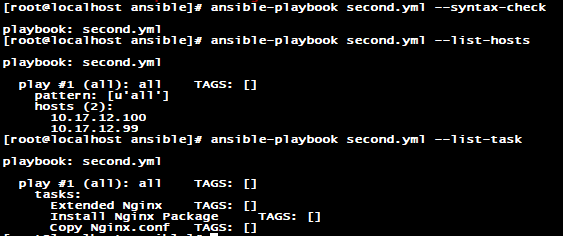
4、执行命令
ansible-playbook second.yml
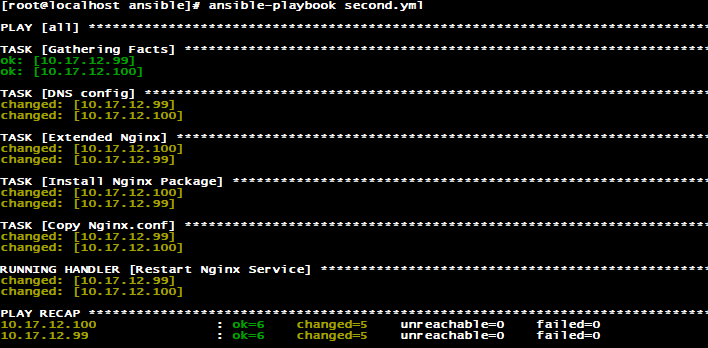
查看检验,各主机nginx都已经安装,并且参数也已经按照需求修改,docker启动状态。


 浙公网安备 33010602011771号
浙公网安备 33010602011771号